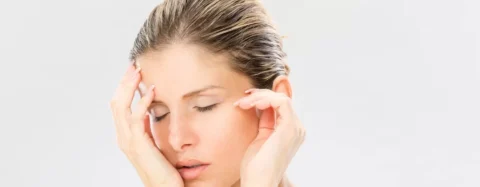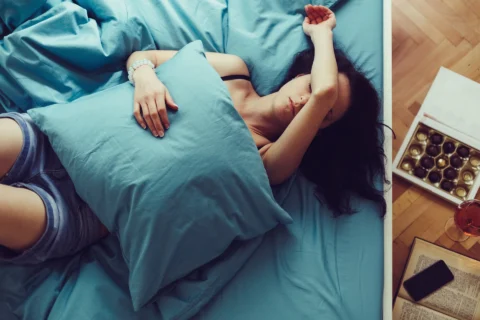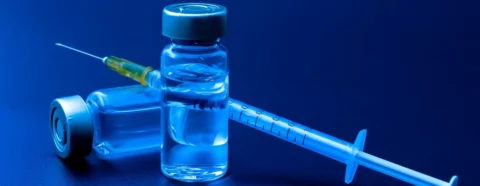Millions of people around the world suffer from migraine, and for an unfortunate few, no treatment, medication, or therapy consistently and reliably alleviates migraine attacks. Migraine pain can stop a person from living a normal life, leaving them incapacitated for several hours or days at a time.
Thankfully, one treatment that is growing in popularity due to its effectiveness in treating migraines is Botox.
So does Botox as a migraine treatment work? Yes, as a preventive treatment for migraines. Some studies report that individuals who experience chronic migraines have their number of migraine days every month reduced by 50% on average.
While it is not totally understood how exactly Botox helps to prevent migraines, some doctors believe it to be linked to the suppression of the migraine-related CGRP protein when Botox successfully paralyzes certain sensory nerves in the head.
Understanding Migraines
What is a Migraine?
Migraines are extremely painful recurring headaches. Around 12% of the US population suffers migraine attacks, with most of those affected being middle-aged women. People who suffer from migraines generally experience them several days per month; a person is considered to have chronic migraine if they experience migraine symptoms on at least 15 days every month.
Migraine Symptoms

Migraines are different from headaches in that they can generally be predicted before the pain begins, whereas the symptoms of a headache only occur during the headache itself.
Migraines are very unique in the way people experience and suffer from them, so there are many symptoms for this condition. Some of the most common migraine symptoms are as follows:
- Nausea (sickness and vomiting)
- Hypersensitivity to sound, light, and smell
- Pain during physical stress
- Pulsing and throbbing pain around the head or on one side of the head
- Sweating
- Diarrhea
- Stomach ache
- Body temperature fluctuations
Causes of Migraine (Triggers)

Migraines are still not completely understood, as the causes, effects, and treatments on individuals can vary from person to person. Some doctors believe that those who experience migraines are simply more genetically predisposed to it, leading to them having more excitable brains; even a small trigger or change in the environment (internal or external) can be enough to lead to a major migraine.
Some of the general triggers of migraine include:
- Diet: Caffeine and alcohol are known to be triggers for migraines in some people. Food related to dairy such as cheese and chocolate, and citrus fruits have also been linked to migraines
- Physical exhaustion: Physical fatigue, neck and shoulder pain, jet lag, and low blood sugar
- Hormonal causes: Menstruation causes immense hormonal fluctuations in the body, leading to migraines in some women
- Excessive stimuli: Smoke, flickering lights, loud sounds, pungent smells – too much stimulation of the senses can trigger migraines
- Emotional events: Too much excitement, stress, anxiety, or any other strong emotion can lead to a migraine
Types of Migraines
Migraines are classified into the symptoms a person experiences. These classifications are:
- Vestibular Migraine: Migraines that strongly lead to feelings to dizziness and vertigo. Known as vestibular migraines due to the relation with the vestibular system, which helps a person identify their surrounding space
- Intractable Migraine: Migraines that last a long time, typically the most severe migraines that can disrupt all activities in a day. Also known as status migrainosus
- Basilar Migraine: Rarer than other migraine types, basilar migraines lead to sensory-related symptoms, such as seeing flashes of light or spots (basilar migraines are generally aura migraines). These migraines are linked to blood vessel constriction, leading to less blood in the brain
There are two major types of migraines: aura migraines and migraines without aura. Both types of migraines produce similar symptoms:
- Neck and shoulder stiffness
- Blurred vision
- Upset stomach
- Pain in the head, usually worse on one side
- Hypersensitivity to senses
The primary difference between the two is the presence or lack of an aura. The aura comes before the migraine, setting in anywhere from 5 minutes to an hour before the pain of a migraine begins. This allows people to start taking preventive measures to stop a migraine before it happens.
While most auras are visual auras – in which a person will see colors and shapes such as blind spots, zigzags, tunnel vision, flashes, and more – other types of auras affect the movement and other senses of a person, leading to:
- Sudden uncontrollable movements
- Muscle weakness
- Auditory hallucinations
- Speech impediments
- Pins and needles sensation
- General confusion of the world around you
Aura migraines generally affect 1 out of 3 people who suffer from migraines, although not every migraine they experience will come with an aura. Aura migraines come in three stages:
- The aura stage: The initial onset aura, leading to symptoms of visual or auditory hallucinations
- The attack stage: The painful headache, lasting anywhere from a few hours to a few days, with feelings of nausea and vomiting
- The hangover stage: Grogginess after the migraine, taking at least a day to recover
The Link Between Women and Migraines

There is a significant difference when comparing men and women who suffer from migraines: around 85% of people who report having migraine symptoms are middle-aged women. As migraines are still not completely understood, doctors continue to study the links between middle-aged women and migraines. One of the most common beliefs is that migraine sensitivity can be found in our sex hormones.
In one study, it was found that testosterone can actually help protect people from migraines; the more testosterone within an individual, the more likely they are to never experience a migraine, or experience lesser or reduced migraine symptoms.
Other sex hormones such as estrogen – the sex hormone most prevalent in women – have been strongly linked to migraine symptoms. Women with the highest estrogen levels (typically women experiencing their menstruation) are most likely to experience migraines.
Do you Need Botox for Migraines?

Botox as a migraine treatment has been used to successfully treat millions of patients worldwide, but are you a potential candidate for migraine-related Botox? Here are some necessary criteria before you consider Botox for your migraine or chronic migraine:
You Have Migraines, Not Headaches: It’s important to know that you are experiencing migraines, not headaches. The International Headache Society has the “5, 4, 3, 2, 1,” system to diagnose migraines.
- You have experienced 5 painful attacks, lasting at least 4 hours up to 3 days each
- Your attacks have at least 2 of the following symptoms: pulsating pain, severe pain, aggravated by physical stress, and generally more painful on one side
- You have at least 1 of the following symptoms: Vomiting, sound sensitivity, light sensitivity, nausea
You Have Tried Oral Treatments: Doctors will generally recommend that an individual tries 2-3 oral treatments for migraine before considering Botox, and these treatments should have no positive effect on the individual. Insurance providers also typically will not cover Botox for migraine until oral treatments have been tried
You Have Tried Non-Pharmaceutical Treatments: Botox should be an option when all other options have been exhausted. If you have tried recommended lifestyle changes to alleviate your migraine pain and reduce your migraine days, and if they are ineffective, then you should consider Botox treatments
You Are Not Allergic (Or Pregnant/Breastfeeding): It is important that a patient isn’t allergic to Botox (which is rare), and that they are not pregnant or breastfeeding (or planning to be pregnant or planning to breastfeed), as it is still unknown as to whether Botox has any effect on unborn or young children
You Have Previous Experience with Botox: Having previous experience with Botox as a cosmetic or medical treatment means a patient is definitely not allergic to the treatment, and they already have some understanding of the treatment process and what to expect
Botox as a Migraine Treatment: Everything You Need to Know

What is Botox?
Botox or onabotulinum A is a neurotoxin protein derived from the botulinum Clostridium bacterium. This bacterium is generally found in bodies of water and soil around the world, and was first observed by doctors in the 18th century, in which contact with the bacterium was leading to unexplained deaths.
It was only in the 20th century when doctors understood how to isolate the muscle-paralyzing factors of Clostridium botulinum, leading to the creation of Botox as a neurotoxin used for various medical and cosmetic purposes.
Read more: The Origin of Botox: How It All Started
The primary function of Botox as a medical and cosmetic treatment is to paralyze or “freeze” muscles and nerve endings in the injection site. The conditions treated by Botox are conditions related to or caused by muscular or nerve disorders, leading to involuntary twitches, spasms, or wrinkles and lines from heavy or overactive muscles.
With Botox, the muscles and nerves behind these conditions become relaxed, leading to the patient’s alleviation from the symptoms for as long as Botox remains in the system. Botox typically lasts anywhere from 3 to 6 months, with some patients reporting effects lasting up to 12 months.
For patients suffering severe conditions, doctors generally recommend maintenance treatments every few months, allowing the Botox effects to last indefinitely.
Some of the medical and cosmetic applications of Botox today include:
- Hemifacial spasm
- Upper limb spasticity
- Blepharospasm
- Severe shoulder muscle spasms
- Severe neck muscle spasms
- Overactive bladder
- Strabismus
- Hyperhidrosis (excessive sweating)
- Glabellar lines
- Crow’s feet
- Fine lines and wrinkles in various facial regions
And of course, Botox has also been found to treat migraines and chronic migraines, with the FDA granting official approval for Botox to be used as a clinical migraine treatment.
Read more: Medical Uses of Botox: Can Botox Treat Medical Conditions?
But how exactly does Botox for migraines work?
Botox as a Migraine Treatment

As discussed above, much is still unknown about migraines. Doctors have found that patients experiencing migraines (or migraine-like symptoms) can be triggered and treated with a full range of options, so research into understanding migraines is still difficult, with so many unexplained variables.
The case of understanding how Botox treats migraines is no different – there is still no direct or clear explanation as to why Botox alleviates migraine symptoms. It is important to note that there are two ways to treat migraines: acute treatment and preventive treatment.
- Acute treatment: This is a migraine treatment that aims to tackle and relieve current pain, allowing a patient who is presently suffering migraine pain to find relief.
- Preventive treatment: This is a migraine treatment that aims to lessen the frequency of migraine occurrences in the future. As chronic migraines are generally defined as headaches that occur in 15 or more days every month, preventive treatment seeks to reduce the overall number of days a patient experiences migraine symptoms every month.
Botox works as a preventive treatment for migraine. And in many cases, the relieving effects of Botox as a migraine treatment do not fully kick in until the third or fourth treatment, leaving many patients initially doubting the efficacy of Botox as a migraine treatment.
Like most applications of Botox, the discovery of Botox as a potential treatment for migraine was an accident. As most patients of Botox (middle-aged to older women) also fall in the same demographic as those who are most prone to suffer chronic migraine, several patients reported in the early 2000s that their Botox for forehead wrinkles had also helped alleviate their migraine symptoms.
After doctors continued to explore various areas to inject Botox, the migraine alleviation continued to improve. In 2010, the FDA approved Botox for migraine when the main supplier of Botox (Allergen) supplied two studies proving the positive effects of Botox on patients with migraines.
How Botox Treats Migraine

So how exactly does Botox treat migraine? While the science behind its proven alleviation of migraine symptoms isn’t fully understood, there are existing theories based on the known effects of Botox in the body.
Botox as a medical and cosmetic application functions by paralyzing or freezing a specific muscle. The specific actions involved in this “paralysis” works at the neurotransmitter level: when the brain “commands” a muscle to contract, a neurotransmitter (a chemical that acts as a transmitter of the command) known as acetylcholine is released by the surrounding nerves. The released acetylcholine sends the message from neuron to neuron, and the muscle responds by contracting.
The presence of Botox in the area prevents this interaction from happening. Botox paralyzes the nerve that sends out the acetylcholine, thus preventing the release of acetylcholine, and consequently blocking the action of a muscle contraction.
In the context of migraines, it is understood that the sensory nerves around the head also release pain impulses when triggered. These pain impulses are accompanied by a protein known as Calcitonin Gene-Related Peptide (CGRP), which has been heavily historically linked to headaches and migraines. When CGRP is released, headache and migraine symptoms begin or worsen.
Botox injected around the muscles of the head is believed to perform the same function to the head’s sensory nerves with CGRP as it does with typical nerves and acetylcholine, preventing the release of CGRP and thus reducing or even preventing the symptoms of migraine.
Botox for Migraine Treatment Experience
Many more people are familiar with Botox as a cosmetic treatment than Botox as a migraine treatment, so the first question that many potential patients ask when considering Botox as their migraine treatment is whether Botox as a migraine treatment is any different from Botox as a cosmetic treatment.
While Botox has many applications, its formula and injection process are typically the same, whether you are getting it for cosmetic, migraine, or other medical purposes. The only major difference between Botox treatments across various applications is the number of injections required.
As it is recommended for each injection to carry just 5 units of Botox, more injections are required for certain treatments than others. The typical facial injection of Botox as a cosmetic procedure may take only a few injections. However, Botox as a migraine treatment requires many more units per session to be effective.
How Many Units of Botox Will You Need for a Migraine?
At least 31 injections of Botox are required for a full treatment of migraine, with 5 units per injection. Some patients can expect up to 40 injections, depending on the severity of their condition and their doctor’s recommendation. The 31 initial injection points are all areas where the nerves are most active during bouts of migraine.
Generally, a set foundation of Botox injections will be administered around the hell; after this, the areas where the migraine pain is most concentrated will receive extra attention if deemed necessary by the doctor.
Here are the various injection sites a patient can expect any Botox for migraine treatment to involve:
| Injection Site | Botox Units | Areas | Muscle Function |
| Corrugator | 1 injection site each side of the forehead, 5 Botox units each | The patient will be required to furrow their brows and hold the skin down; injection will be just above the superior orbital rim | Depressor of the brows |
| Procerus | 1 injection site at the midline area, 5 Botox units | The patient will be required to furrow, allowing the injection to enter at a 90-degree angle; injection will be just about halfway between the corrugator injection sites | To add stability to the brows and the forehead |
| Frontalis | 2 injection sites on each side of the forehead, 5 Botox units each | Highest third of the forehead, found above the corrugator injection sites; needle will enter at a 45-degree angle | To raise the brows |
| Temporalis | 4 injection sites on each side of the head, 5 Botox units each | Injection sites are located roughly 1-3 fingerbreadths above the top of the ear, with one nearer to the brow and the furthest back along the back of the ear; needle will enter at an upward 45-degree angle | Allows the teeth to press and clench |
| Occipitalis | 3 injection sites on each side of the head at the back, 5 Botox units each | Injection sites located at the back of the head, laterally level with the ears; needle will enter at a 45-degree angle | The anchor at the back of the skull to stabilize the frontalis |
| Cervical paraspinal | 2 injection sites on each side of the back of the head, 5 Botox units each | Roughly around the place where the skull connects with the spine at the top of the neck and the bottom of the skull, with one injection site on each side slightly higher than the other | To balance the neck |
| Trapezius | 3 injection sites on each shoulder, 5 Botox units each | The injection sites are located at the top of each shoulder, three along the shoulder coming from the neck | To stretch the neck |
Botox for Migraine Experience
Any Botox for migraine begins with a consultation for the patient. The doctor will address their migraine and whether they have tried other options before opting for Botox injections.
Typically, insurance companies in the United States do include Botox for migraine in their plans, however for an insurance provider to cover your Botox for migraine treatment, they require you to try around 3 other preventive treatments or medications, with little to no positive results experienced.
If you have tried other treatments for migraine (generally oral treatments) and have experienced negative side effects or no changes to your migraine, then you can be covered by most insurance plans for a Botox for migraine treatment.
An advantage of Botox is that unlike some oral medications, it has no interaction with any other treatment you may be currently taking for unrelated health issues. Only patients with neuromuscular disorders or who are pregnant (or aiming to be pregnant) should avoid Botox as a migraine treatment.
The treatment itself is quick and easy – many doctors report that explaining the treatment and the injection sites takes longer than actually performing it. The patient is asked to lie down, and an anesthetic will be applied and allowed to settle prior to the injections.
The doctor will then mark the injection sites and inject the Botox around the head and neck; patients can expect at least 31 injections, and up to 40 injections for certain cases. Patients are recommended to have one session of Botox injections every 12 weeks; the overall number of sessions a patient will need depends on their results and reaction to the Botox.
Read more: First Time Getting Botox? Here’s a Short Guide
Botox Side Effects

The most common side effects reported by patients who undergo Botox for migraine treatment include headaches and neck pain, however in most cases these should go away after a few days.
Other possible side effects from Botox include:
- Muscle weakness leading to breathing, speaking, and swallowing issues
- Possible botulinum toxin spread from site of injection, leading to:
- Eyelid droop
- Muscle fatigue
- Strength loss
- Bladder control loss
- Blurred vision
- Loss of voice
- Rash, itching, dizziness
Before your Botox injection, inform your doctor if you have conditions related to the nerves or muscles, including:
- ALS
- Lambert-Eaton syndrome
- Myasthenia gravis
- Lou Gehrig’s disease
Other medical conditions you should inform your doctor of include:
- Bleeding issues
- History of surgery (particularly facial surgery)
- Facial changes
- Pregnancy or intention of pregnancy
- Breastfeeding or intent to breastfeed
- Forehead muscle weakness
- Eyelid droop
Allergy Side Effects
If you have never experienced a Botox injection for any purpose before, there is a possibility that you might have an allergic reaction to it. Allergic reactions of Botox can include swelling in the legs, breath shortness, and hives around the injection sites.
If you believe you might be allergic to Botox, have your doctor inject you with a small amount before your full treatment, and observe any allergic reactions. If you have had a history of allergic reactions to any product with botulinum toxin, including Dysport and Myobloc, then it is recommended to avoid any Botox injection.
Injection Side Effects
As with any treatment procedure that involves injections, there is always the possibility of injection-related side effects caused by inexperienced handling of the needle. If the injection site has any rash or skin infection, it is advised to wait until the skin heals before being injected with Botox.
Non-Botox Migraine Treatments

Migraines can be treated through lifestyle changes, and individuals with migraines should try these options before pharmaceutical treatments. Lifestyle changes associated with migraine pain reduction include:
- Regular exercise
- Reducing stress levels
- Making sure you are sleeping enough
- Drinking enough water
- Avoiding food that triggers the pain
If you believe that Botox treatment is not for you, or you would like to try other migraine treatments before considering Botox, here are other proven migraine treatments:
Prescription Drugs, OTC Drugs – Before considering Botox as a migraine treatment, it is highly recommended for individuals with migraine to try at least 2-3 oral medications. These come in the form of both prescription drugs and over-the-counter drugs, including:
- NSAIDs: NSAIDs, or nonsteroidal anti-inflammatory drugs, include drugs such as naproxen, ibuprofen, diclofenac, and aspirin. These drugs are effect for both mild and severe migraines.
- Antiemetics: Antiemetic drugs are drugs that fight against symptoms of nausea, since nausea is a common side effect of severe migraines.
- Ergotamine: Ergotamine is known for its effect of bringing quick pain relief to individuals suffering from migraines. This drug is not recommended for those who experience frequent migraine attacks due to its side effects on the cardiovascular system.
- Triptans: Triptans are the most common drug prescribed for migraines due to their ability to increase serotonin levels in the brain, as low serotonin levels are associated with migraines.
- Preventive drugs: There are a variety of preventive drugs available for migraine, with different drugs working (and not working) for certain patients. These drugs include antidepressants, anticonvulsants, and antihypertensives.
Neuromodulation Therapy – Neuromodulation is the stimulation of the spinal cord or the brain, with the intention of suppression or encouraging certain central nervous system functions. The FDA has approved two neuromodulation therapies:
- Transcutaneous supraorbital nerve stimulation: Using a device placed on the head of the patient to generate magnetic impulses for stimulation of the supraorbital nerve in the brain, used as a preventive migraine treatment
- Single-pulse transcranial magnetic stimulation: Using a device placed on the head of the patient to generate magnetic impulses that stimulate the brain, used for acute migraine
Acupuncture – While some still see acupuncture as an ancient form of physical therapy, recent studies over the last few years have proven various scientific medical application of acupuncture as a treatment for certain conditions, including migraines.
One study found that patients who experience migraines without aura can greatly benefit from acupuncture, with the therapy reducing the intensity and frequency of the pain. Sufferers of migraines should turn to acupuncture if they are seeking non-pharmaceutical treatments.
Meditation – Another form of non-pharmaceutical treatment for migraines is meditation. Various studies have observed the benefits associated with meditation on pain relief from migraines. It has been found that individuals with migraine attacks who begin practicing forms of spiritual meditation experience significant migraine pain reduction.
Doctors believe this has to do with the focus on mind and muscle relaxation with meditation, which seems to lessen the aggravation of the conditions that typically result in migraine attacks.
Dietary Supplements – Certain dietary supplements have been found to reduce the number of migraine days for patients suffering chronic migraine conditions. These supplements include:
- Butterbur
- Melatonin
- Magnesium
- Riboflavin
- Coenzyme Q10
Botox as a Migraine Treatment at Ethos Spa
At Ethos Aesthetics + Wellness in New Jersey, our team of medical specialists have performed countless Botox treatments, for both cosmetic and medical purposes. If you would like to learn more about Botox as a migraine treatment, call us and schedule your free consultation right away.
Say goodbye to your migraine days with Botox treatments and change your life today, only at Ethos Spa.







